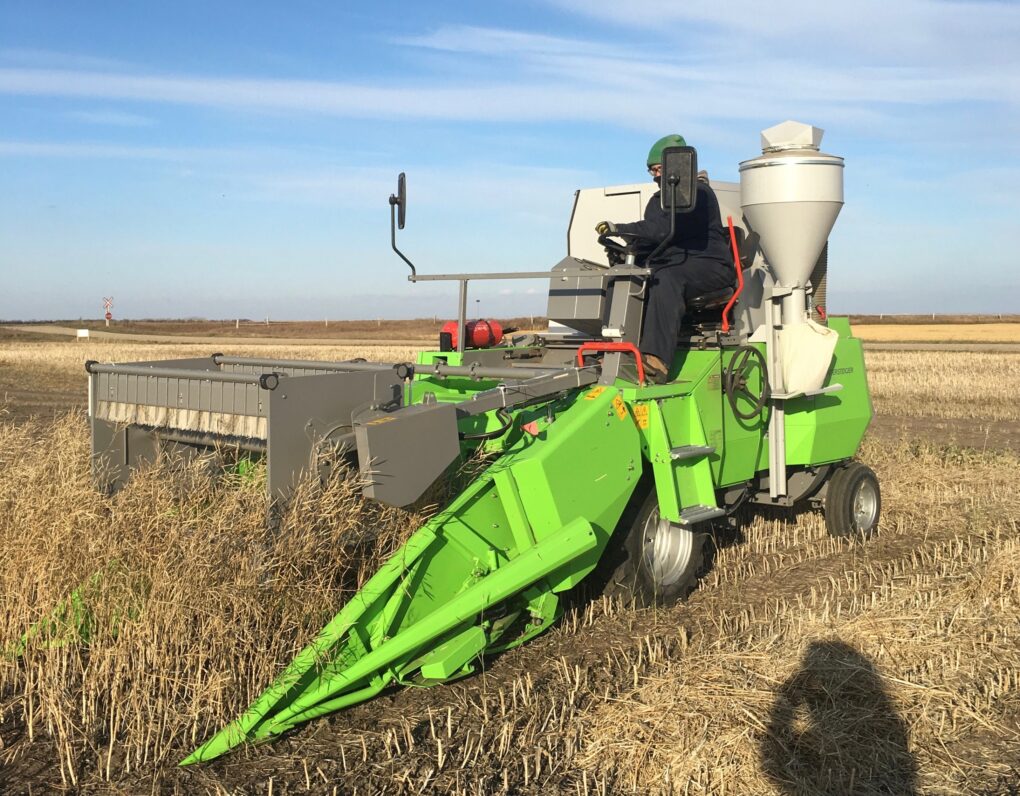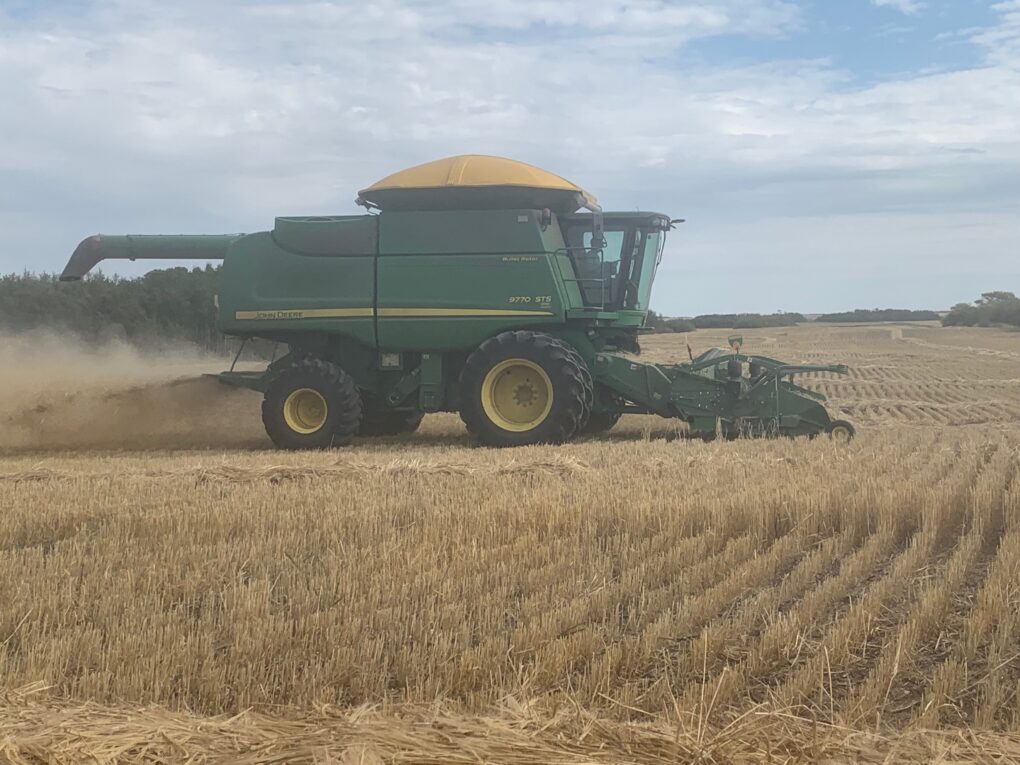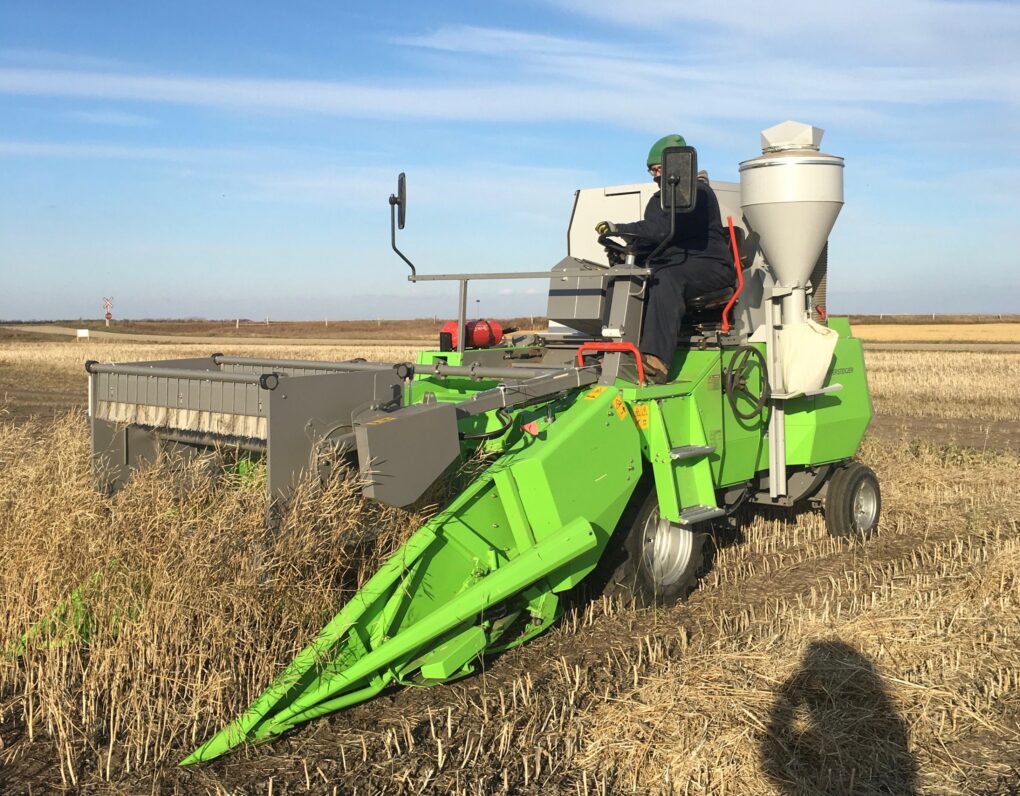Part 6: Harvest
This is the sixthof a series of #LabToField blogs that will explain the yearly cycle of variety development. Click here to read Part 1: Phytotrons, Part 2: Agriculture Greenhouses, Part 3: The U of S Seed Lab, Part 4: Seeding, or Part 5: Data Collection.
The hot summer days have come to an end! Farmers and crop researchers alike spent the summer carefully tending to their crops. They scouted for diseases, insects, and weeds, made chemical applications, and watched the skies hoping for rain and praying the dark clouds in the distance would not bring hail. Now the season of harvest has arrived and it is time for farmers and researchers to reap the benefits of their hard work. When we think of harvest on the Canadian prairies, we imagine large-scale machinery, semi-trucks for grain transport, and bins filled with grain. However, harvest in a crop-breeding program looks a little different, which we will explore in the following blog.
Harvest Preparation
Just like farmers, crop researchers have ample preparation to do before the harvest season. One preparation is the harvest tags, which are created for each individual plot to be harvested. It’s all about staying organized. This means each tag includes the trial name, plot number, and variety identifier to ensure that the grain from each plot remains separated and labelled. While it may seem simple, this process is one of the most important parts of harvest preparation. A mix-up in the creation, ordering, or tying of harvest tags could result in an unidentified bag of grain or two bags with the same tag, causing major problems for the analysis and selection process.
Harvest preparation is not all that unlike large-scale farming. In research, machinery maintenance must also be completed prior to harvest to ensure that once conditions are right, harvesting can smoothly commence. And depending on the crop, variety, end-use requirements, and trial objectives, some plots need a little extra work before collecting the crop for harvest. This may include swathing a plot, which means cutting down the crop and laying it in a row to be reaped, or desiccating it, a spray application to kill and dry the crop prior to harvest. After all preparation is completed, it becomes a waiting game until the crops are at the perfect harvest stage and moisture content.
Harvesting Research Plots
When the crop stage and weather conditions are favourable, harvest can begin! Both mechanical and hand-harvesting methods are used to harvest crop research plots. In very early breeding generations, single plants are often taken from the most-promising varieties to be grown in the next generation. Often, these early generations are grown in single rows instead of plots, making mechanical harvest more difficult as most plot combines are designed to take up entire plots instead of single rows. In situations where a plot combine is not feasible or available, plants are often hand harvested using sickles or knives. Afterwards the harvested plants will be threshed in the field or put into bags and threshed later. Hand-harvesting is an effective, and often necessary, method for harvesting research trials, however, it is quite time-consuming and requires a large labour force.
In later stages of breeding research, or research programs in which the plants are grown in typical plot formations, plot combines can be used. These combines are relatively small and are only as wide as the research plots. Each plot is harvested separately to allow for complete isolation of the grain from each variety. To harvest each individual plot, the combine cuts and takes up the mature plant material. Like large-scale combines, the cut plant is then threshed within the machine, the straw is sent out the back, and the grain is funneled to a chute where it is bagged for collection. Once all of the grain has moved through the combine and funneled down the chute into the bag, a researcher removes the bag, ties it closed, and attaches the corresponding harvest tag for identification. They then wrap a new harvest bag around the chute in preparation to catch the grain from the next plot to be harvested. This process is repeated for each research plot in a study until all of the grain has been collected.


What Comes Next?
Once the grain is harvested from the plots, testing and analysis must be conducted. Similar to regular farming, the seeds are usually cleaned to remove any chaff, dirt, debris, or weed seeds that may have mixed in with the harvested grain. Once again, ensuring that the seeds from each plot remain separated from the others is essential.
After cleaning the next stage of research begins, in which various tests can be conducted to determine the qualities of the harvested grain. For U of S breeding programs, most of these tests are conducted at the Grain Innovation Lab. The tests conducted at this laboratory will be explored in the next blog.
Just like for farmers, harvest is an anxious time for researchers. After putting in the long hours during the summer, the results of the harvest are largely dependent on the weather. While the equipment, personnel, and crop maturity might be ready for harvest, an untimely rain will halt all progress until conditions dry up. Yet, harvest is also one of the most exciting times of the year as farmers and researchers are able to measure their success. The hard work and long hours put in by crop researchers and farmers alike, especially during the busy harvest season, lead to innovative crop varieties available to farmers and ultimately to the safe, healthy food enjoyed by Canadians every single day.


Pingback: New Crop Varieties: The Journey from Lab to Field - Varietal Testing at the U of S Grains Innovation Lab -